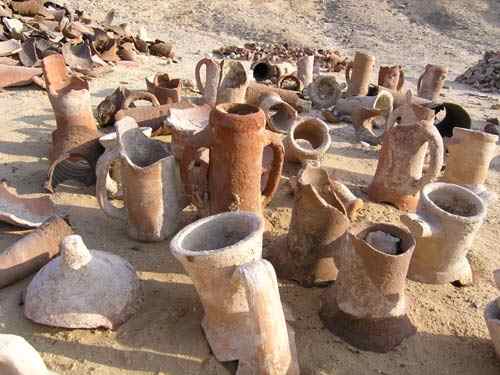
The Quseir shipwreck is what remains of an ancient Roman shipwreck located at Quesir which dates from between the 1st century B.C. and the 1st century A.D. believed to have belonged to Emperor Augustus and may have been on an outbound voyage to India.
The location of the wreck has been known to the Institute of Nautical Archaeology-Egypt (INA-Egypt) since 1993 and surveys conducted in 1994 by the team of Douglas Haldane revealed Campanian amphorae (A cylindrical two-handled amphora with oval-section handles and an almond-shaped rim) from Italy on the wreck site which assisted in dating the poorly preserved wreck lying in 65 meters of water near the ancient harbor.
The wooden ship was strongly built and was approximately 33 meters in length, would have possibly been carrying Italian wine, gold and silver to be used as currency, and also contain articles and implements of daily life aboard ship. Excavation of the harbor and former settlement at Quseir EL-Qadim have provided indicators pointing towards trade with India. The port, called Myos Hromos or “Mussel Harbor”, at that time was the Roman Empire’s main port for trade with North Africa and points beyond and is mentioned in the texts of Pliny, Strabo, and Periplus. Imported goods would arrive at Myos Hromos and then be shipped north to the port of Quft, and then on to Alexandria for shipping to the rest of the Mediterranean.
Imported products included stone from Yemen, textiles and pottery from India, wares from China, and amphorae from the upper Mediterranean. The quantity of amphora sherds located along the coast line of Quseir EL-Qadim indicate that a massive amount of overseas trade occurred here and reaffirm the importance of Myos Hromos as a center of trade for the Roman empire and later during the Islamic period.
According to Strabo II.5.12: “Again, since the Romans have recently invaded Arabia Felix with an army, of which Aelius Gallus, my friend and companion, was the commander, and since the merchants of Alexandria are already sailing with fleets by way of the Nile and of the Arabian Gulf as far as India, these regions also have become far better known to us of to-day than to our predecessors. At any rate, when Gallus was prefect of Egypt, I accompanied him and ascended the Nile as far as Syene and the frontiers of Ethiopia, and
I learned that as many as one hundred and twenty vessels were sailing from Myos Hormos to India, whereas formerly, under the Ptolemies, only a very few ventured to undertake the voyage and to carry on traffic in Indian merchandise.”
And from the Periplus of the Erythraean Sea: “Of the designated ports on the Erythraean Sea, and the market-towns around it, the first is the Egyptian port of Mussel Harbor. To those sailing down from that place, on the right hand, after eighteen hundred stadia, there is Berenice. The harbors of both are at the boundary of Egypt, and are bays opening from the Erythraean Sea.”
Concerning the Quseir Shipwreck, there were plans to conduct an initial survey of the wreck site in 2002, however, these plans were postponed at that time until appropriate dive safety measures were put in place due to the depth at which the wreck lies. However, information concerning if and when a survey or excavation was conducted after that time has yet to be located.
http://www.fordham.edu/halsall/ancient/periplus.html
http://penelope.uchicago.edu/Thayer/E/Roman/Texts/Strabo/2E1*.html
http://en.wikipedia.org/wiki/User:Rktect/Etham
http://www.potsherd.uklinux.net/atlas/Ware/MRCA
http://www.marzouk-dc.com/html/about_desert_egypt.html
http://www.allempires.com/article/index.php?q=egypt_india_ancient_relations
“At Empire’s Edge, Exploring Rome’s Egyptian Frontier” By Robert B. Jackson
http://www.adventurecorps.com/sadana/94survey.html
http://ina.tamu.edu/fieldprojects01a.htm
“Myos Hormos – Quseir al-Qadim: Roman and Islamic Ports on the Red Sea”, by David Peacock and Lucy Blue 2006


